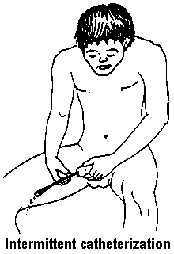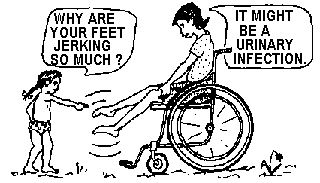CHAPTER 25
Life-Saving Innovations in Bladder Management
by Spinal-Cord Injured Persons

The 2 biggest causes of death in spinal-cord injured persons are
pressure sores and urinary tract infections.
Most persons lose urine control. They may dribble uncontrollably or be
unable to relax the muscles that let urine pass. Specialists mostly agree
that often the best way to reduce the frequency and severity of urinary
infections is to use intermittent catheterization. That
is to say, every 4 hours or so the person puts a thin rubber tube
(catheter) through the urine opening (in the penis or vulva) and into the
bladder to drain the urine. This is a lot safer than using a catheter that
stays in place. A permanent (Foley) catheter, which is
normally changed every 2 weeks, runs a higher risk of introducing
infection.
Nevertheless, in some countries, doctors caring for spinal-cord injured
persons often keep them on a permanent catheter, perhaps because they
think that they will not live long in any case. It is very
important that spinal-cord injured persons and their families communicate
with and learn from one another, and not simply follow
what their doctor tells them. Some doctors consistently give good
advice; others do not.

As we will discuss in Chapters 27 and
28, spinal-cord injured persons need to
learn new ways of listening to their bodies. Because they usually have no
feeling or pain below the level of their injury, they must discover other
ways to spot difficulties. For example, when a person's legs begin to jerk
uncontrollably, or spasticity increases, or she feels feverish, dizzy, or
sweaty, these are warning signals. Somewhere, pressure on her skin may be
causing a risk of pressure sores. Or a urinary infection may have started.
The person learns to watch for these signs and to look for the causes.
This new body language can be life-saving. Just as deaf
people learn to "listen" in new ways, so do spinal-cord injured persons.
There are no better teachers than other spinal-cord injured persons,
especially the long-time survivors.
THE STERILIZATION DEBATE. Doctors used to insist that
spinal-cord injured persons must sterilize their catheter by boiling it
before each use. As a result, users often went long periods without
catheterizing. This led to more frequent infections and to kidney damage.
Then, spinal-cord injured persons began to discover that clean
catheterization gave results that were as good as
sterilized catheterization. Because it was easier, people tended
to do it more often and regularly, and so they were healthier. Clean
sterilization became an underground art, taught to newly injured persons
by survivors.
In the USA, doctors have at last begun to recommend clean rather than
sterile catheterization. Not long ago, I was delighted to hear a urinary
specialist (urologist) approve clean catheterization technique for a
paraplegic boy, explaining, "If you want people to catheterize
regularly, you have to encourage the method that is simplest and easiest."
Still, international rehabilitation professionals have criticized the book
Disabled Village Children for giving "dangerous recommendations"
for catheterization without boiling the catheter. The spinal-cord
injured community needs to pressure such experts to learn from disabled
persons' experience.
|
Using Double Catheters in a Plastic Bag to Reduce Infection
Even a boiled or sterile catheter can introduce infection. This is
because there are always bacteria (germs) in and around the urinary
opening of the penis or vulva, regardless of how well they are cleaned.
More than 25 years ago, after years with frequent infections, Ralf
Hotchkiss and other paraplegic friends in California began looking for
safer ways to catheterize themselves.
| One innovation was to keep the catheter in
a plastic "zip-look" bag with a bit of antiseptic solution.
Hydrogen peroxide works well and is non-irritating. It can be very
dilute; a 3-percent solution is fine. To use the catheter, push its
tip out of a corner of the bag and into the urinary opening. Make
sure the fingers touch only the plastic bag, not the catheter.
Another innovation is to use 2 catheters, one inside the
other. The first (outer) catheter is inserted 1 or 2 cm
into the urinary opening, past the area with the most germs. Then
the inner catheter is inserted through the outer one.
By combining both the above innovations (using double catheters
and keeping them in a plastic "zip-lock" bag with antiseptic
solution), Ralf has greatly reduced his urinary infections. |

Diagram from the package of the MMG O'Neil Urinary
Catheterization System, showing the top of the plastic bag. |
THE COMMERCIAL PRODUCT. This combined method proved
to give excellent results. It is now factory-produced as the MMG
O'Neil Urinary Catheterization System. Unfortunately, it is
outrageously expensive. But with a little creativity, people can make
their own. Or the commercial system, though sold for a single
catheterization, can be used repeatedly for several weeks, like this:
|